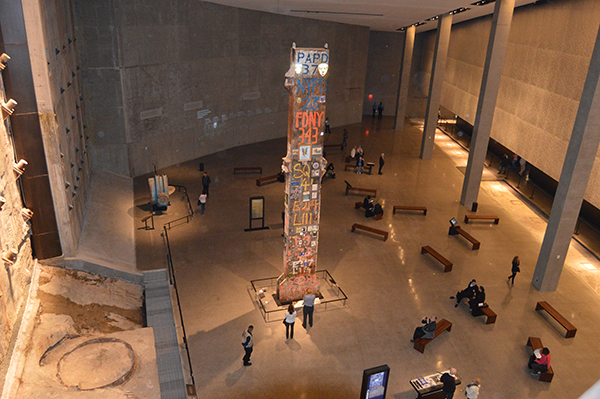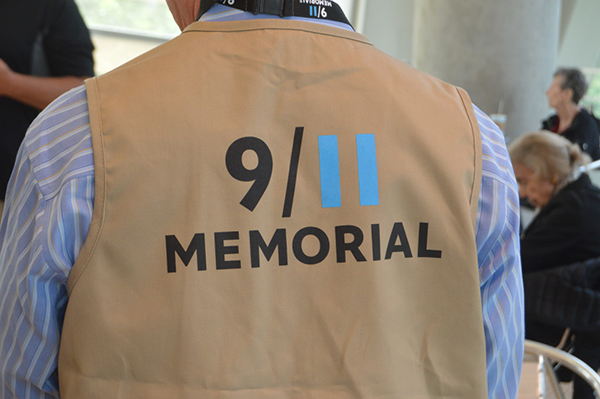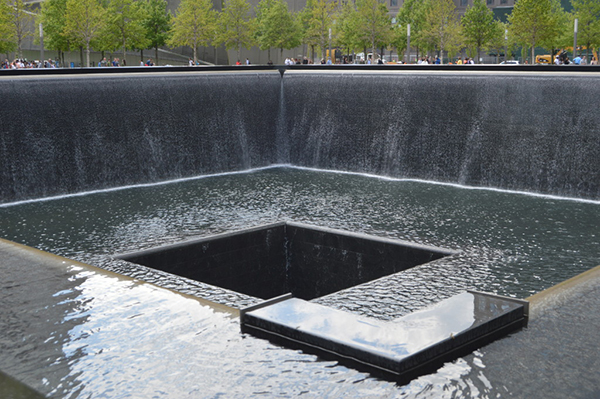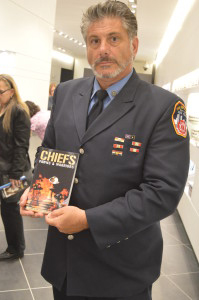
An Emotional Journey: Jaws of Hell to Hope and Peace

By Bob and Sandy Nesoff
Just the mention of 911 stirs emotions and memories that could easily be compared to the feelings a country felt on December 7, 1941 when a cowardly flotilla of Japanese war planes attacked Pearl Harbor and murdered 2,403 military and civilians.
The Muslim terrorists who hit the World Trade Center murdered 2,996 innocent people simply beginning their day at work…more bodies than were in the Arizona, the other ships and the military bases and airfields across the island combined.
Those who were there, for the most part, have suffered a form of PTSD and vividly remember the concrete dust and paper falling from the sky. But mostly they remember the smell and smoke and knowledge of what it was that was burning besides the buildings.
Two years ago a memorial plaza was opened in the footprints of the two giant buildings with a beautifully designed place of peace and contentment for visitors to remember what had taken place.
At the end of May the long awaited 911 Museum opened adjacent to the plaza. As with anything else done in this country there was a degree of controversy. But more on that later.

Anyone who was on site on September 11, 2001 found the drive to the museum a gut-wrenching experience. The closer you got the tighter the stomach muscles. The memory of all the empty ambulances sitting at the Javits Center, unused because there were precious few injured to transport; the firemen at Vesey Street rushing to give responders paper masks to filter out the ever present concrete dust; and the Tyvek-suited personnel walking into the hell in a vain hope of finding survivors.
Most first responders and recovery personnel forced themselves to visit the museum… because they had to. They had to make the connection and perhaps gain some closure. But the underlying fear of standing where the “pile” lay, 20-stories high and smoking for weeks after the attack, was omnipresent.
Parking in the area was a chore, the short walk giving time for reflection and wonderment as to how it would all be presented. First Responders and recovery workers were given admission to the museum before it was opened to the public and afforded them time to slowly make their way through the exhibits and reflection.
The museum in Oklahoma City at the site of the Murrah Federal Building destroyed by a sick domestic terrorist was well done but very intense. Even those who had not lost loved ones could feel the intensity of the exhibits.
The 911 Memorial Museum is not Oklahoma City. It is not the Murrah Museum.

The New York City 911 Memorial and Museum vividly tells the story. It leaves nothing out. But it is a place where those most affected by the terror attack can truly come, pay respects and not leave as a bundle of nerves.
Visitors first arrive at a reception desk where they may obtain headsets for a vocal description of each and every display in the museum. Many visitors eventually took the headsets off, opting instead to slowly walk the floors, look at the exhibits and read the descriptive plaques by every item.
Pictures of the Twin Towers as they stood, majestically, until they were destroyed by evil men following the calling of a religious perversion, adorn the early sections of the museum as you walk down a sloping pathway.
There are the remnants of a NYPD patrol car, two burned and crushes fire engines, a section of the huge antenna that sat atop the building. And there were the personal items: a badge, partially melted, from the uniform of a female Port Authority police officer, melted helmets of fire fighters who rushed into the building in an effort to save lives and, instead, lost their own.
There is a piece of a fuselage of one of the planes that crashed into the buildings with a window that a passenger no doubt sat and watched as his fate drew near. There are seatbelts that held passengers snugly as they died a fiery death.
There is a room on which three walls are covered with photos of those who died. They are in alphabetical order making it easy for loved ones to find the photo of the one they lost.
A crumbling concrete staircase, known as “The Survivors Staircase” runs alongside a downward escalator. The steps were the path to light and life for many of those evacuating the building before the collapse. It was removed in one huge section and repositioned in the museum. Look closely and you may be able to envision people orderly scrambling for their lives.
As to the controversy about the museum: The fact of the matter is that nothing is ever accomplished without some controversy and dissenters. With all due respect to those who lost loved ones on this horrific day, the museum is low key and very respectful. There is an obvious effort to address the feelings of survivors.
There were complaints about the museum store that sells souvenirs. In fact those coming to the museum cannot see the inside of the store unless they enter it. There is a sign at the entrance but to get in you must walk around a curved wall that shields it from public view.Another complaint regarded a VIP cocktail party just before the general opening. The party was to thank major donors without whom the facility could not have been built. The museum receives no public funding and must raise its $60 million operating budget dollar by dollar.
The objectors are few in number compared to survivors and families. Their feelings should be respected but should not be permitted to overrule or overshadow this outstanding memorial.

One of those at the Museum Store on a day prior to the public opening was a former New York City fireman, Ron Parker. Ron served at Ground Zero on 911 and many days after. He discussed his book, Chiefs, Pawns & Warriors with another author who had been there on 911 as well.
Parkers book is an excellent read and transmits the feelings of those who rushed in and lost friends.
Check out his book at www.AuthorRonParker.com
You might also be interested in watching a video of the dedication of the Memorial Plaza by 15-year-old. Matt Naimaister.
Check out www.youtube.com/watch?v=1cDT_TrDMAw
The author was a first responder on the night of 911 and volunteered at the site many times after.

